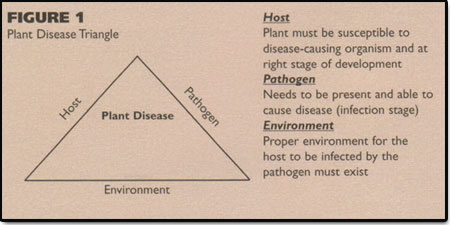
Best Way of Keeping Diseases off Balance!
This has been the case in southern Ontario, where we have seen an increase
in soybean diseases from reduced crop rotations. Diseases on the rise
include soybean cyst nematode, white mould, phytophthora root rot, rhizoctonia
root rot, sudden  death
syndrome, stem canker and brown stem rot. It is necessary that producers
increase their rotation options by keeping corn, wheat or other crops
in the rotation.
death
syndrome, stem canker and brown stem rot. It is necessary that producers
increase their rotation options by keeping corn, wheat or other crops
in the rotation.
Crop rotation provides producers with one of the most effective and economical
methods of controlling plant diseases. Unfortunately, the importance of
a good crop rotation is often overshadowed by other considerations. Some
of the benefits that crop rotations provide producers include: (i) increased
yields, (ii) optimal utilization of nutrients, (iii) erosion control,
(iv) insect and weed control, (v) labour and machinery requirements spread
over a larger portion of the growing season, and (vi) reduced disease
risk.
How does disease develop in your
field? Imagine the disease potential
of your field as a equal-sided triangle where the three sides are labelled
host, pathogen and environment. The interaction of these three factors
determines the disease risk potential of your field. Plant pathologists
refer to this as 'The Disease Triangle'. For a disease to occur, the plant
and pathogen have to come together under suitable environmental conditions.
If any of these three factors are absent, disease development is either
reduced or not possible at all.
Management is one way you can reduce or minimize the disease risk potential
in your field. For example, if you switch a susceptible host with either
a non-host crop or a resistant variety, disease development is stopped.
The same goes for the pathogen: if it is not present or is not in an infective
stage, then little or no disease!!!
The important thing to remember is that the pathogen has to b e
physically present for a disease to occur. This is a point that growers
sometimes forget and, at times, it is tempting to think of disease outbreaks
as being related to the weather or some other factor. When less then ideal
environmental exist, the pathogen's ability to cause disease on a susceptible
host is reduced. Visually think of it as a narrow triangle, since the
three sides no longer have an equal influence on disease potential.
e
physically present for a disease to occur. This is a point that growers
sometimes forget and, at times, it is tempting to think of disease outbreaks
as being related to the weather or some other factor. When less then ideal
environmental exist, the pathogen's ability to cause disease on a susceptible
host is reduced. Visually think of it as a narrow triangle, since the
three sides no longer have an equal influence on disease potential.
The best method of minimizing the proliferation of disease inoculum is
by using a rotation or crop sequence in which each crop is resistant to
the diseases of the crop grown the previous year. Most pathogens survive
in crop residue, but only for a limited time, and most pathogens do not
infect multiple crops. Crop rotation reduces the potential for serious
infestations of pests associated with one specific crop or its residue.
For this reason, it is important that we do not sway off course since
the consequences will be greater economic losses from yield decreases
due to pests (disease, insects, weeds) as well as other factors and increased
production costs (fertilizer, pesticides, etc ).
Now is the time to sit down and contemplate how to keep corn and wheat
in your rotation. Overuse of any one crop will increase disease pressure.
By rotating, you minimize your potential for serious disease outbreaks
since each crop is resistant to the diseases of the previous year's crop.
So take full advantage of this very effective management tool and ROTATE!
ROTATE! ROTATE! You won't be
sorry!